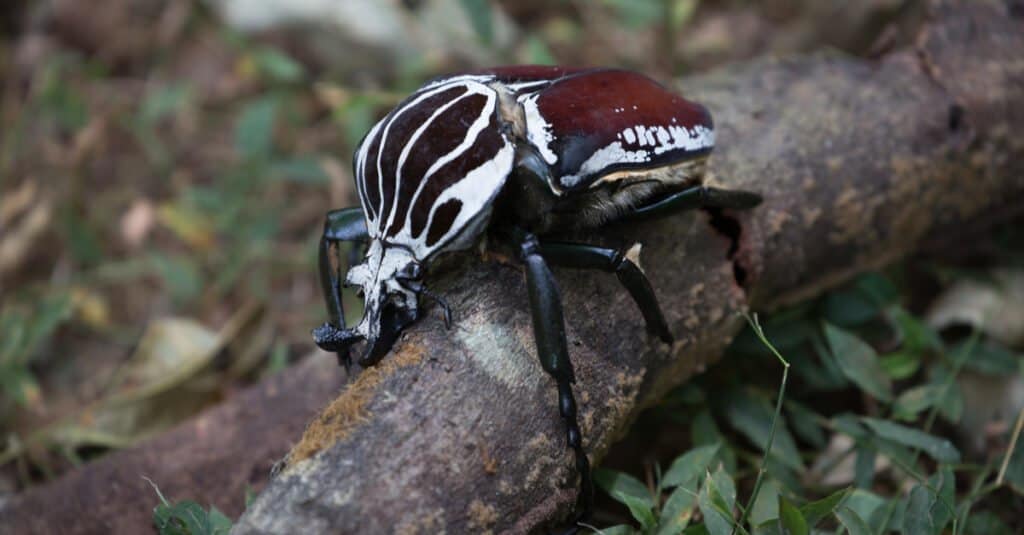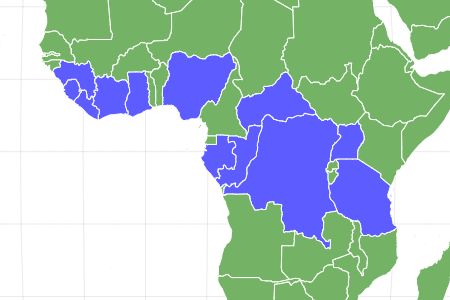Goliath Beetle
Goliath beetles are the largest beetles in the world, and they can carry objects several times their weight.
Advertisement
Goliath Beetle Scientific Classification
Goliath Beetle Facts
- Name Of Young
- larvae
- Group Behavior
- Solitary
- Fun Fact
- Goliath beetles are the largest beetles in the world, and they can carry objects several times their weight.
- Habitat
- Africa's tropical forests
- Predators
- lizards, frogs, birds, and rodents
- Diet
- Omnivore
- Favorite Food
- tree sap and fruit
- Type
- insect
- Common Name
- Goliath Beetle
- Special Features
- The outerwings forms a chitinous elytra
- Number Of Species
- 6
- Location
- Africa
View all of the Goliath Beetle images!
Goliath beetles are the largest beetles in the world, and they can carry objects several times their weight.
Summary
Goliath beetles refer to any of the six species of beetles in the genus Goliathus. As their name implies, goliath beetles are the largest beetles in the world. Interestingly, their weight is highest when they’re juveniles and lighter as adults. All species of goliath beetles are native to Africa. They can be found in the tropical and subtropical rainforests of southeast Africa.
Goliath Beetles Species, Types, and Scientific Name
Goliath beetles are any of the six beetle species in the genus Goliathus. They are insects and belong to the family Scarabaeidae (scarab beetles). There are up to 30,000 species of scarab beetles worldwide. They’re characterized by their stout body and bright, metallic colors.
Some of the most common scarab beetles include dung beetles, rose chafers, rhinoceros beetles, and Japanese beetles.
The name goliath beetle is an obvious reference to the biblical giant goliath due to the large size of the beetle. There are six species of beetles in the genus Goliathus. These include:
- Goliathus albosignatus
- Goliathus cacicus
- Goliathus goliatus
- Goliathus kolbei
- Goliathus orientalis
- Goliathus regius
All 6 species of goliath beetles are native to Africa. They live in tropical and subtropical rainforests in the southeastern region of Africa. The largest of this is the G. orientalis, while the smallest species in the giant beetle genus is the G. albosignatus. In addition to these, there is a rare species known as G. atlas. This is only formed when a crossbreed happens between G. regius and G. cacicus.
Appearance
Goliath beetles are the largest beetles in the world. They’re also the heaviest, with an average weight of 80–100 grams (2.8–3.5 oz) in the larval stage. The adults typically have about half of this weight (an average of 1.8oz). Goliath beetles are also very strong. These beetles can lift weights that are up to 850 times their own body weight.
Male goliath beetles are typically bigger than female ones. The males can measure as much as 6–11cm (2.4–4.3 in) as adults, while females are typically between 5–8cm (2.0–3.1 in) in length. In addition to being bigger, males also tend to have a Y-shaped horn on their heads. They typically use this horn for intraspecies fights during mating and when defending their territory.
The head of the female goliath beetle is typically wedge-shaped, and this makes it easy for them to burrow through soil. They have six legs and sharp claws, which are used for climbing trees. Goliath beetles have two sets of wings, but only the inner wings are used for flying. The outer wings form a thick chitinous exoskeleton called elytra. This covering protects the beetle’s inner wings and abdomen. They typically open their elytra to expose the softer inner wings they fly.
Coloration
The coloration of the insects in the Goliathus genus depends on their species. Coloration may also vary between male and female members of the same species. Typically, the color is a mix of black, white, and brown. For the G. goliatus, the color is predominantly black with white stripes. They’re the only species in the genus with a reddish coloring on their back. This makes them quite popular among people that breed or collect these beetles.
The G. regius and G. orientalis are mainly white with black spots or patches. G. cacicus is mostly brown with black and white spots, while G. albosignatus is black with brownish-orange and white spots.

Goliath beetles are the largest and heaviest beetles in the world.
©Nickolas warner/Shutterstock.com
Habitat: Where To Find Goliath Beetles
All species of goliath beetle are found in Africa. They typically live in locations with warm climates in southeast Africa. They may also be found in tropical and subtropical regions as well. In places where they’re found, these giant beetles live in dense rainforests.
Diet: What Do Goliath Beetles Eat?
Adult goliath beetles typically have a diet that consists predominantly of foods with high sugar. Tree sap and rotten fruits form a major part of their diet. They typically use their sharp claw-like jaws to break tree barks and fruits. Their mouths typically have a wooly area that looks like a paintbrush. These are small fiber pieces that they use for sipping juice from fruits.
Juveniles typically have a different diet which includes plant matter, dung and animal remains. In the wild, they play an important role in the ecosystem by aiding the decay of plant and animal matter.
It is possible to raise goliath beetles in captivity. Collectors and breeders often feed them with pellets of dog or cat food. To add some variety to their diet, breeders often add leaves, and pieces of food to the larvae’s diet. These beetles can live for up to a year in captivity. This is because they have protection from predators and adverse weather conditions. This is even longer than they live in the wild.
What Eats Goliath Beetles?
Predators of insects such as lizards, frogs, birds, and rodents may feed on goliath beetles. These beetles are most vulnerable when they’re in the larvae form. During this stage, they have no natural defenses against predators.
Related Insects
View all 170 animals that start with GGoliath Beetle FAQs (Frequently Asked Questions)
Are goliath beetles dangerous?
Goliath beetles don’t have teeth. However, their mandibles are large enough to deliver a sharp pinch similar to an insect bite. Due to the size of their mandibles, the goliath beetle’s bite can draw blood. However, they’re not venomous, which means they’re not really dangerous.
How many legs does the goliath beetle have?
Goliath beetles have three pairs of legs. They also have sharp claws, which they use for climbing trees, as well as two sets of wings.
How strong is a goliath beetle?
Goliath beetles are considered one of the strongest insects in the world. They’re capable of carrying weights up to 850 times their body weight.
Do goliath beetles fly?
Due to their large chitinous outer wings, it might seem like goliath beetles cannot fly. However, they have soft inner wings which are used for flying. They can spread their elytra to reveal the pair of flying wings underneath.
Thank you for reading! Have some feedback for us? Contact the AZ Animals editorial team.
Sources
- Wikipedia, Available here: https://en.wikipedia.org/wiki/Scarabaeidae
- Thought Co, Available here: https://www.thoughtco.com/goliath-beetle-4775832
- Facts, Available here: https://facts.net/goliath-beetle-facts/
- Britannica, Available here: https://www.britannica.com/animal/flower-chafer#ref156940
- Wikipedia, Available here: https://en.wikipedia.org/wiki/Goliathus

















